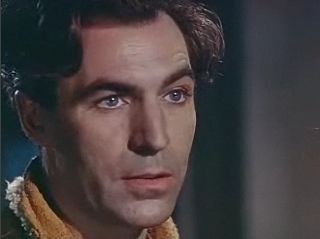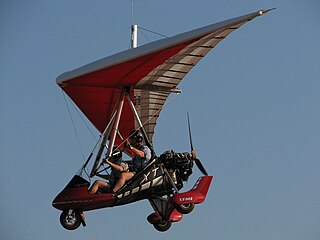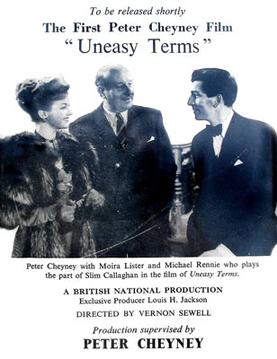
Hang gliding is an air sport or recreational activity in which a pilot flies a light, non-motorised, fixed-wing heavier-than-air aircraft called a hang glider. Most modern hang gliders are made of an aluminium alloy or composite frame covered with synthetic sailcloth to form a wing. Typically the pilot is in a harness suspended from the airframe, and controls the aircraft by shifting body weight in opposition to a control frame.

A fixed-wing aircraft is a heavier-than-air aircraft, such as an airplane, which is capable of flight using aerodynamic lift. Fixed-wing aircraft are distinct from rotary-wing aircraft, and ornithopters. The wings of a fixed-wing aircraft are not necessarily rigid; kites, hang gliders, variable-sweep wing aircraft, and airplanes that use wing morphing are all classified as fixed wing.

The Army Air Corps (AAC) is the aviation arm of the British Army, first formed in 1942 during the Second World War by grouping the various airborne units of the British Army. Today, there are eight regiments of the AAC, as well as two independent flights and two independent squadrons deployed in support of British Army operations around the world. Regiments and flights are located in the United Kingdom, Kenya, and Canada. Some AAC squadrons provide the air assault elements of 16 Air Assault Brigade Combat Team, through Joint Aviation Command.

Sir Alan John Cobham, KBE, AFC was an English aviation pioneer.

The Northrop XP-79, USAAF project number MX-365, was a rocket and jet-powered flying wing fighter aircraft, designed by Northrop. The pilot operated the aircraft in a prone position, permitting him to withstand much greater g-forces in pitch. It also used a welded magnesium monocoque structure instead of riveted aluminum.

The Glider Pilot Regiment was a British airborne forces unit of the Second World War, which was responsible for crewing the British Army's military gliders and saw action in the European theatre in support of Allied airborne operations. Established during the war in 1942, the regiment was disbanded in 1957.

Alan Derek Piggott was one of Britain's best known glider pilots and instructors. He had over 5,000 hours on over 153 types of powered aircraft and over 5,000 hours on over 184 types of glider. He was honoured for his work on the instruction and safety of glider pilots. In 1961 he became the first person to make an officially authenticated take-off and flight in a man-powered aircraft. He also worked as a stunt pilot in several feature films.

Sonia Dresdel was an English actress, whose career ran between the 1940s and 1970s.

David Farrar was an English stage and film actor.

An ultralight trike or paratrike is a type of powered hang glider where flight control is by weight-shift. These aircraft have a fabric flex-wing from which is suspended a tricycle fuselage pod driven by a pusher propeller. The pod accommodates either a solo pilot, or a pilot and a single passenger. Trikes grant affordable, accessible, and exciting flying, and have been popular since the 1980s.
Staff Sergeant James Harley Wallwork DFM was a British soldier and a member of the Glider Pilot Regiment who achieved notability as the pilot of the first Horsa glider to land at Pegasus Bridge in the early hours of D-Day, 6 June 1944, during the Second World War. This achievement was described as "the greatest feat of flying of the second world war" by Air Chief Marshal Sir Trafford Leigh-Mallory. Although most noted for his part in the Battle of Normandy, Wallwork flew gliders in every major British airborne operation of the Second World War. These also included the Sicily landings, Arnhem and the Rhine Crossings. In later life he lived in Vancouver.

Gallant Journey is a 1946 American historical film written, produced and directed by William A. Wellman and starring Glenn Ford, Janet Blair and Charles Ruggles. The film is a biopic of the early U.S. aviation pioneer John Joseph Montgomery. Gallant Journey depicts his efforts to build and fly gliders, from his childhood through to his death in 1911. The chief stunt pilot for the film was Paul Mantz. It was produced and distributed by Columbia Pictures. It is also known by the alternative title The Great Highway.

Royal Air Force Tarrant Rushton or more simply RAF Tarrant Rushton is a former Royal Air Force station near the village of Tarrant Rushton east of Blandford Forum in Dorset, England from 1943 to 1947. It was used for glider operations during World War II and later revived for civilian operations. It is currently disused, though some buildings survive. Today it serves as a visual reference point (VRP) for VFR flights, in particular NW departures from Bournemouth Airport.

Vernon Campbell Sewell was a British film director, writer, producer and, briefly, an actor.

Judy Leden, MBE is a British hang glider and paraglider pilot. She has held three world champion titles, twice in hang gliding, once in paragliding.

During World War II civilian flying schools, under government contract, provided a considerable part of the flying training effort undertaken by the United States Army Air Forces.
Fifty-Shilling Boxer is a 1937 British comedy film directed by Maclean Rogers and starring Bruce Seton, Nancy O'Neil and Moore Marriott. The plot revolves around a young circus boxer who tries to build a career in the world of professional boxing.

Jack Edwards Livesey was a British film actor.

Uneasy Terms is a 1948 British crime thriller film directed by Vernon Sewell and starring Michael Rennie, Moira Lister and Faith Brook. It is based on the 1946 novel of the same name by Peter Cheyney.
Journey Together is a 1945 British drama war film directed by John Boulting and starring Richard Attenborough, Jack Watling, John Justin and Edward G. Robinson. It is Boulting's film directorial debut. The film was produced by the Royal Air Force Film Production Unit. Dramatist Terence Rattigan, then a Royal Air Force Flight Lieutenant, was posted in 1943 to the RAF Film Production Unit to work on The Way to the Stars and Journey Together.

















